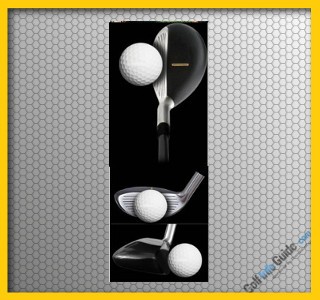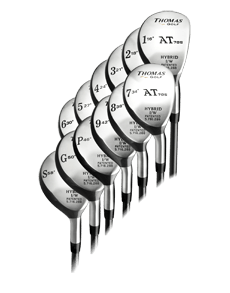 In golf, it is no secret that finding yourself in a hazard can be a challenging situation. Hazards such as bunkers, roughs, or even water can wreak havoc on your scorecard. When it comes to recovery shots from hazards, many golfers wonder if hybrid clubs can be used effectively. Hybrid clubs, also known as utility clubs, are known for their versatility and forgiveness. Let's explore whether they can indeed be a helpful tool for recovery shots from hazards.
In golf, it is no secret that finding yourself in a hazard can be a challenging situation. Hazards such as bunkers, roughs, or even water can wreak havoc on your scorecard. When it comes to recovery shots from hazards, many golfers wonder if hybrid clubs can be used effectively. Hybrid clubs, also known as utility clubs, are known for their versatility and forgiveness. Let's explore whether they can indeed be a helpful tool for recovery shots from hazards.
The Advantages of Hybrid Clubs
- Hybrid clubs are designed with a combination of features from both irons and woods. This unique design allows for better control and accuracy compared to traditional long irons.
- They feature a lower center of gravity which helps in launching the ball higher and creating greater distance, making them great for getting out of tricky situations.
- Hybrids also have a larger clubface, providing more forgiveness and increasing the chances of making solid contact with the ball.
- Their wider sole design reduces the likelihood of the club digging into the ground, which is especially helpful when playing from challenging lies in hazards.
Recovery Shots from Bunkers
When faced with a bunker shot, traditional wisdom suggests using a sand wedge or lob wedge due to their specialized design for soft sand. However, hybrid clubs can also be effective in these situations.
The key to using a hybrid club from a bunker is to open the clubface slightly and play the ball slightly further back in your stance. This helps to increase the bounce on the club and allows the wedge-like sole of the hybrid to glide through the sand. The longer shaft of the hybrid club can provide extra leverage and distance, making it easier to clear the lip of the bunker.
Recovery Shots from Roughs
Getting stuck in the rough is a common occurrence for golfers. The thick grass and unpredictable lies make it difficult to impart spin and control on the ball. This is where hybrid clubs can come in handy.
Due to their wider sole design, hybrid clubs are less likely to get caught up in the thick rough compared to slender irons. The larger clubface helps to minimize the twisting effect caused by the longer grass, increasing the likelihood of making clean contact with the ball. Additionally, the lower center of gravity aids in launching the ball higher, allowing it to clear the rough more easily.
Recovery Shots from Water Hazards
Water hazards can be particularly intimidating, but hybrid clubs can still be used effectively for recovery shots in these situations.
The key to using a hybrid club from a water hazard is to ensure a clean and crisp strike on the ball. The forgiving nature of hybrid clubs allows for a greater margin of error, decreasing the likelihood of slicing or hooking the ball further into the hazard. Using a hybrid club can also help generate more distance, increasing the chances of carrying the hazard and landing safely on the green or fairway.
Update:
Hybrid clubs can be used for recovery shots from hazards. In fact, many golfers find hybrid clubs to be ideal for this purpose. Hybrid clubs are designed to be versatile and forgiving, making them well-suited for a variety of shots, including recovery shots from hazards.
Here are some of the benefits of using a hybrid club for recovery shots from hazards:
- Versatility: Hybrid clubs are versatile clubs that can be used for a variety of shots, including recovery shots from hazards. Hybrid clubs can be hit from a variety of lies and can be used to generate a variety of trajectories.
- Forgiveness: Hybrid clubs are generally more forgiving than other types of clubs, such as irons and fairway woods. This makes them a good choice for golfers who are struggling to hit the ball consistently.
- Distance: Hybrid clubs can generate a good amount of distance, which can be helpful for getting out of hazards.
- Control: Hybrid clubs offer good control, which can be helpful for hitting the ball to a specific target.
If you are looking for a club that can help you to improve your recovery shots from hazards, a hybrid club is a good option to consider.
Here are some tips for using a hybrid club for recovery shots from hazards:
- Choose the right loft: The loft of the hybrid club you choose will depend on the type of hazard you are trying to escape from. If you are trying to escape from a deep hazard, you will need a hybrid club with more loft. If you are trying to escape from a shallow hazard, you can use a hybrid club with less loft.
- Make a smooth swing: It is important to make a smooth swing when hitting a hybrid club from a hazard. A jerky or rushed swing can cause you to hit the ball off-center.
- Focus on hitting the ball with the center of the clubface: Hitting the ball with the center of the clubface will help to maximize your distance and accuracy.
- Be patient: It takes time and practice to master recovery shots from hazards. Don't get discouraged if you don't see results immediately. Just keep practicing and you will eventually start to see improvement.
If you are struggling to hit hybrid clubs from hazards, you may want to consider taking lessons from a qualified golf instructor. A good golf instructor can help you to identify the cause of your problem and develop a plan to fix it.
In conclusion, hybrid clubs can indeed be used for recovery shots from hazards in golf. Their versatility, forgiveness, and unique design make them a valuable tool in navigating challenging situations. However, it is important to practice and experiment with different techniques to find what works best for individual golfers. So, the next time you find yourself in a hazard, give your hybrid club a chance to rescue your score!





